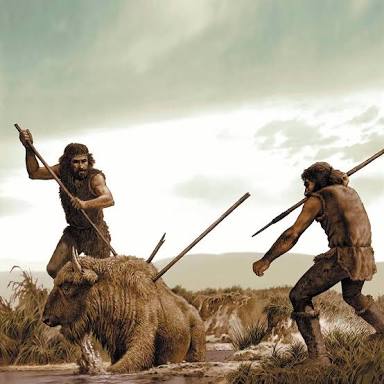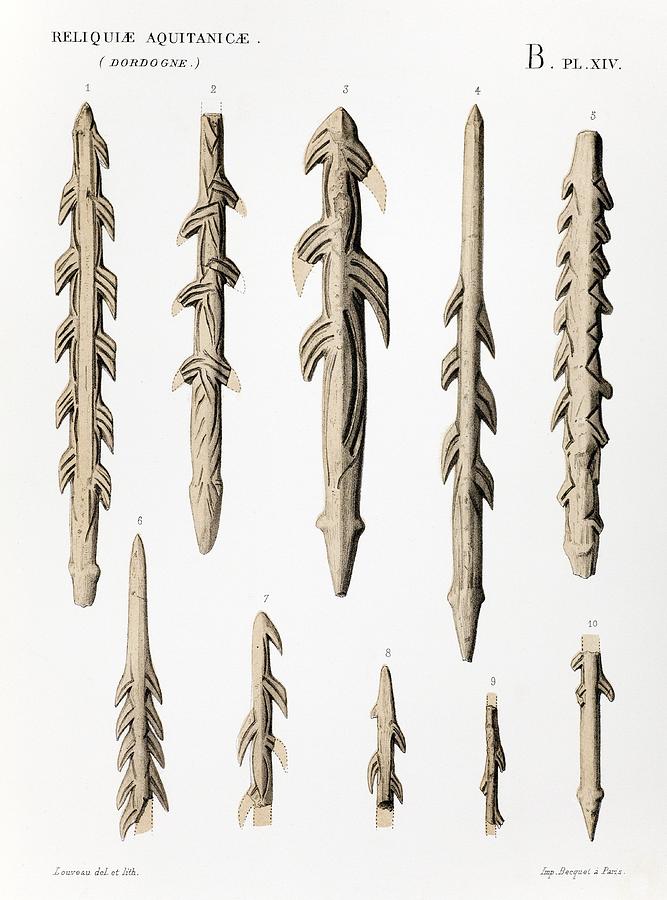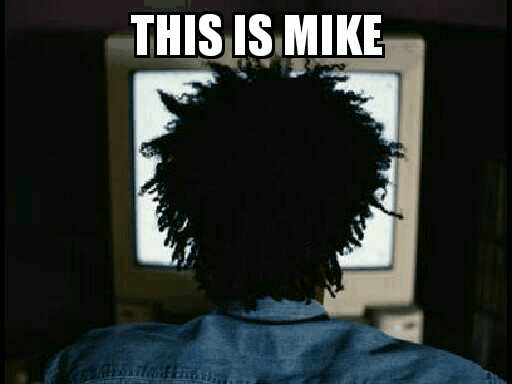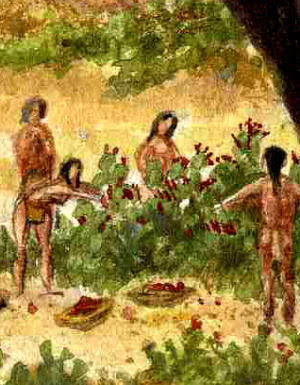History & Food: How Prehistoric Man Hunted And Fished.
Lying in wait for food
.jpg)
The group of silent hunters squatted patiently in the bushes and tall grasses near a herd of grazing bison. At a signal, the men jumped to their feet, hurling stones, waving branches, shrieking and yelling. Heading for the only area that the men had left clear, the startled herd ran for their lives into apparent safety- but stampeded straight over the cliff edge to their deaths on the rocks below. The trick had paid off: there would be plenty of meat for the hunters and the other tribe members to eat.
Stalking the strong, preying on the weak
The earliest hunters preyed on weak animals- those that were injured, hungry or sick, stuck in a swamp or burdened by young offspring, for example. Alternatively, the herds were attacked with stone axes and spears at vulnerable moments, such as when the animals were crossing a deep river. Cunning hunters could mount ambushes at cliff edges. The development of the spear-thrower around 10,000 BC brought more quarry within range. This was a short, notched baton in which the butt of a spear was wedged before throwing. In effect, it lengthened the thrower's arm and gave him greater leverage. By the time the bow and arrow had arrived, around 7,500 BC, it was possible for small bands of hunters to slay large, fleet-footed animals.
Tracking skills were essential for successful hunting, although there were other ways to lure and ensnare prey. Hunter built enclosures near dry river beds and stampeded animals towards them. When the animals swerved at the last minute, they found themselves encircled. Early man also dug pits at the apex of a V-shape formed by two converging rock or earth walls, the widest side of which faced a stream or grazing pasture where the quarry gathered. The hunters drove the animals between the walls into the pit, from which escape was impossible. Some pits contained embedded stakes, sharpened at their tips, on which the animals were impaled.
.jpg)
Keeping Track
Early hunters knew regular migration routes of large mammals such as bison and deer. They also made pictures of their prey.
Extended Arm
Two-legged man was always at a disadvantage against fleet-footed animals, so a bone spear-thrower- which allowed the hunter to attack from farther away, was a considerable asset.
Efficient Killing
The bow and arrow soon displaced stone axes and spears as the hunter's preferred weapon.
The role of the gatherers
But even the most ingenious and cunning hunters could supply no more than a thrid of any group's annual food requirements. The meat contributed eesential protein, but the bulk of prehistoric people's diet did not come from hunting.
Plants and smaller animals were a more reliable source of food, and gathering them was the role of women and children. They gathered berries, nuts, roots, grasses, grubs and insects, using flint axes and sticks to dig up shoots and roots. If they carried spears, it was not to kill, but mainly to protect themselves in case of attack by dangerous animals.
New weapons to exploit a different food source
As many a prehistoric hunter found to his cost, spear fishing required skill and patience. Crouched on a rock on a river bank, next to a dugout canoe, the fisherman scanned the water in front of him for the telltale flicker of a fish. As soon as he saw one, he plunged his bone or flint-tipped spear through the water and into the fish before hauling it onto land.
Some 10,000 years ago as the last Ice Age came to an end, fish became an increasingly important source of food for many peoples of northern Europe. As the climate warned up, the scrubby vegetation of the tundra was replaced first by light woodland and then by forests. The reindeer and mammoths- long an imprtant food source, moved northwards with the receding ice and men learned to hunt smaller forest animals. Those who live near the sea, rivers and lakes started to fish methodically. It was no longer sufficient to rely on picking up stranded or slow-moving fish with the bare hands. Specialized spearheads were carved from antlers with barbs down the side and bound to wooden shafts- the barbs stopped the fish from sliding off after they had been speared. Three-pronged spears worked in the same way: the central prong speared the fish, while the others kept it from wriggling off.
Before fish-hooks were invented, the gorge- a baited silver of bone attached to a line of leather or sinew- played an important role. As the fish swallowed the bait, the gorge stuck in its gullet and the fish could be hauled in.

Versatile Bones
From the earliest days, people have carved and sharpened bone into weapons and tools. The angled barbs on the spearhead and harpoon head held fish in place. Both tools are around 30,000 years old. Later, more refined bone tools included early fish-hooks.
Nets and funnels to trap the catch
A team of men working from the shore or in shallow waters could catch a large number of fish at once by using nets made of flax or hemp. These were weighted with stones and supported by wooden floats to keep them spread wide. More productive was the setting of permanent fish traps, however. Spawning salmon and other fish were caught in pool traps, where they could be easily speared or gathered by hand, or more sophisticated traps woven out of vegetable material. These long, funnel-shaped baskets had a wide entrance, which the fish could swim into, only to find themselves unable to escape.

.jpg)
.jpg)
.jpg)
Interesting article. I like reading about where man came from and what they ate. Where did you gather your info from?
No bro you are great. I like your blog @iknowhow
Thank you bro. Stay tuned for more. ;)
I like your history.
I like it too. :) Thanks!
Yes, you are welcome
@iknowhow
I appreciate the effort you take to write your posts! Really ni
Congratulations @iknowhow! You have completed some achievement on Steemit and have been rewarded with new badge(s) :
Click on any badge to view your own Board of Honor on SteemitBoard.
For more information about SteemitBoard, click here
If you no longer want to receive notifications, reply to this comment with the word
STOP